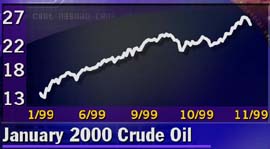|
Exxon-Mobil merger done
|
 |
November 30, 1999: 5:10 p.m. ET
FTC OK paves way for $81B deal after promise to sell 2,400 stations
|
NEW YORK (CNNfn) - Oil powerhouses Exxon Corp. and Mobil Corp. completed their $81 billion merger Tuesday, shortly after the U.S. government approved the deal following a promise the two would sell more than 2,400 stations across the country.
The 4-0 vote by the Federal Trade Commission, which was expected, comes roughly a year after industry leader Exxon (XON) announced its plan to buy Mobil, the No. 2 company in the field. Antitrust concerns held up the approval of that purchase; the firms directly competed in at least 40 metropolitan U.S. areas.
To pave the way for the deal, Exxon and Mobil agreed to sell 2,431 gas stations primarily in the northeastern United States, California and Texas, making this the largest divestiture ever required by the commission. The FTC’s 11-month review of the deal was also one of the longest by the commission.
"Because Exxon and Mobil are such large and powerful competitors and because they now compete in several product and geographic markets in the United States, the commission insisted on extensive restructuring before accepting a proposed settlement," FTC Chairman Robert Pitofsky said in a statement.
"This settlement should preserve competition and protect consumers from inappropriate and anticompetitive price increases," he added.
Exxon Mobil Corp., as it now will be known, is the biggest of the three "supermajors” that includes Anglo-Dutch venture Royal Dutch/Shell and U.K.-based BP Amoco, which awaits regulatory approval for its purchase of U.S.-based Atlantic Richfield.
Exxon defended the deal, the largest in a string of consolidation moves in the industry, citing price pressure on crude oil, the need for greater efficiency and new competitive threats overseas.
The new company expects savings of about $2.8 billion per year and plans to cut some 9,000 jobs, or about 7.3 percent of its workforce. The company will keep the Mobil and Exxon brands; headquarters will be in Exxon’s home in Irving, Texas.
As part of the accord, Exxon and Mobil agreed to sell or reassign 1,740 stations across mid-Atlantic states, 360 stations in California, 319 in Texas and 12 in Guam.
Among the divestitures, Exxon agreed to scrap an option to buy gasoline stations from Tosco Corp. in Arizona, divest its Benicia, Calif., refinery and its jet turbine oil business, and will stop selling diesel fuel and gasoline in California under the Exxon name for at least 12 years.
Exxon will sell its fee and leased service stations from New York to Maine, while Mobil will shed its fee and leased service stations from New Jersey to Virginia.
Also as part of the FTC consent order, a buyer of any of the divested gas stations would have a right to continue to use either the Exxon or Mobil brands for at least a decade after the purchase.
Reassembling pieces of Standard Oil
The merger, first announced last December, brings back together two pieces of the former Standard Oil Co., the Rockefeller-run oil titan that was split apart in 1911 due to a Supreme Court decision.
When they announced the deal, Exxon and Mobil insisted it was necessary to help them find greater efficiencies amid low crude oil prices last year. Low oil prices put the squeeze on a company’s margins in its "upstream” activities, or their exploration and production operations.

Since then, oil prices have rebounded and are hovering near a nine-year high. Prices of many top oil producers have rebounded as a result. Shares of Exxon, one of the 30 Dow industrial average issues, fell 1/16 to 79-5/16 in New York Stock Exchange trade on Tuesday. The combined company will trade under the Exxon ticker symbol XOM.
And in its last day of trading on the NYSE, Mobil (MOB) gained 7/8 to close at 104-3/8. 
-- from staff and wire reports
|
|
|
|
|
|
Exxon
Mobil
|
Note: Pages will open in a new browser window
External sites are not endorsed by CNNmoney
|
|
|
|
 |

|

